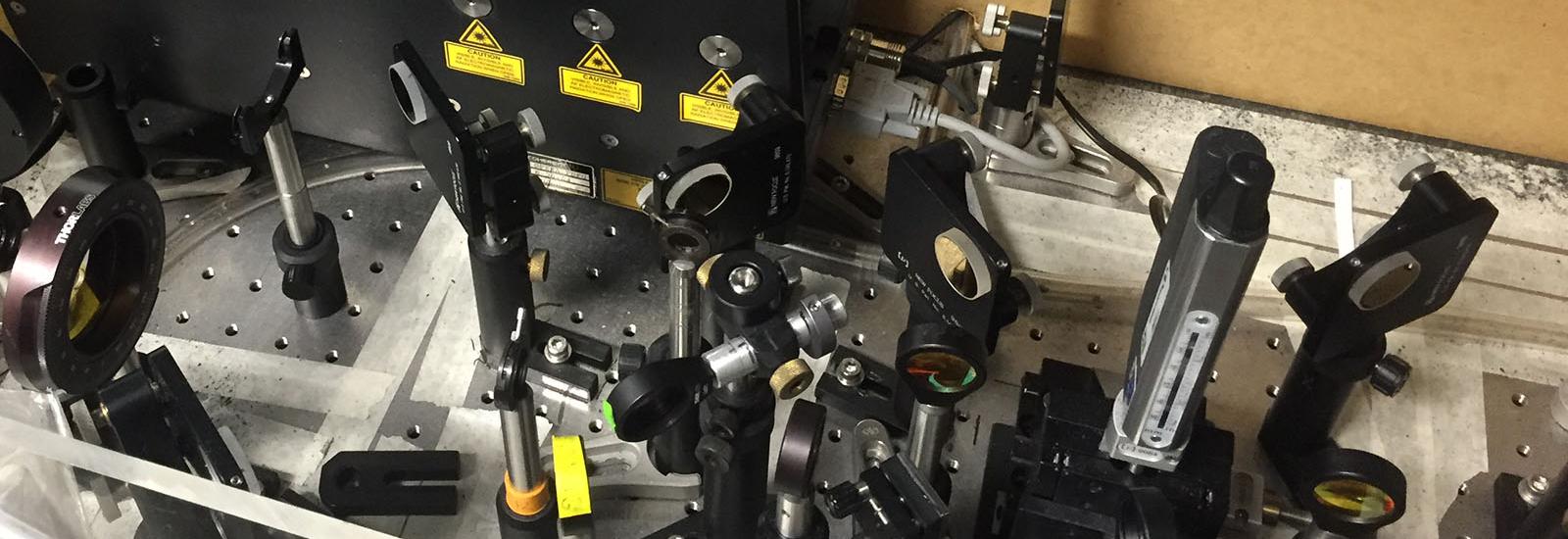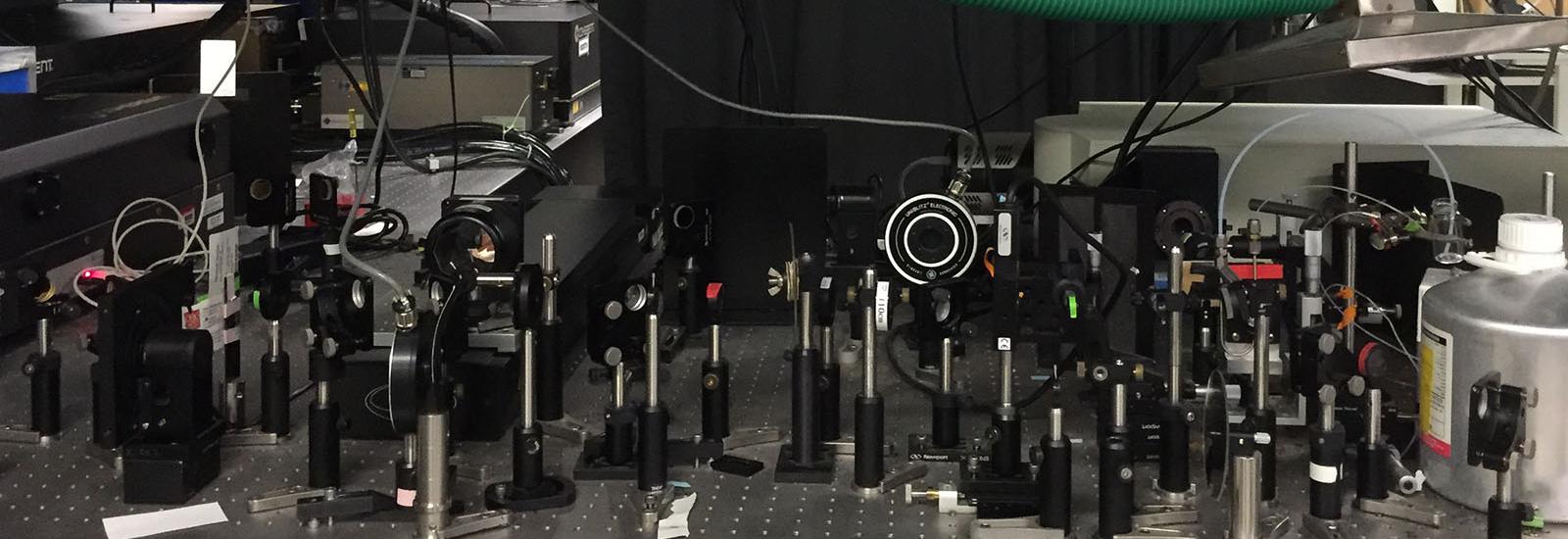The Center for Chemical and Biophysical Dynamics (CCBD) was set up to provide OSU faculty, staff, and students as well as external users with access to state-of-the art femtosecond laser spectroscopy instrumentation. Users can complete training to run their samples or samples can be sent to the manager to be run. The CCBD has the equipment necessary to measure broadband transient absorption (TA) and time resolved infrared (TRIR) on femtosecond time scale. These experiments can measure how the excited state of a molecule can decay back to the ground state on the femtosecond to 4.0-nanosecond time scale. Probing detection is setup to be transmissive, so samples must be transparent, either liquid or film.
Since its creation in 2004, the CCBD has grown to include other instruments that use light or lasers to measure samples. These instruments include:
- Horiba Fluorolog-3 with accesories
- Renishaw inVia Raman Microscope
- PhotoThermal mIRage-LS
- PerkinElmer Spectrum 65
- Shimadzu UV-3600
- Applied Photophysics Stopped-Flow
Dynamic Instrumentation
Femtosecond Transient Absorption (fsTA)

Transient absorption (TA) spectroscopy measures the evolution of the electronic absorption after a sample is excited. During the experiment, a pump pulse is used to excite the sample, followed by a probe pulse at variable time delays, which for TA is a visible (400-750 nm) white light. By measuring the transmission of the probe through the sample, it is possible to measure the decay of the excited state created by the pump pulse as a function of time.
Time-Resolved Infrared (TRIR)
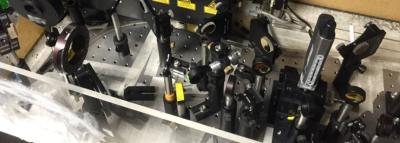
Femtosecond time resolved infrared (TRIR), like TA, uses a pump pulse that to excite the sample. The difference is that instead of a visible probe, the probe is in the IR electromagnetic range and is used to measure the decay in IR active vibrations in the sample.
TCSPC on Fluorolog
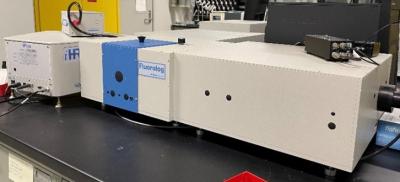
The Horiba Fluorolog-3 has the accessories needed for lifetime measurements using time-correlated single photon counting (TCSPC). This set up is ideal for measure time-resolved photoluminescence on the picosecond to nanosecond time scale. The instrument uses diodes for exciting the sample. The diodes available are 285, 450, 510, and 670 nm.
AppliedPhotophysics SX-20 Stopped-Flow Spectrometer
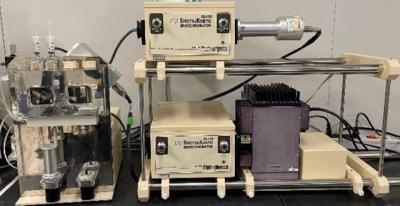
In a stopped-flow spectrometer, two reagents are mixed. The mixed solution is then irradiated and by measuring changes in absorption the kinetics of the reaction can be calculated. The instrument has a dead time of 1 ms and can measure kinetics out to 16 minutes.
Steady State Instrumentation
Renishaw inVia
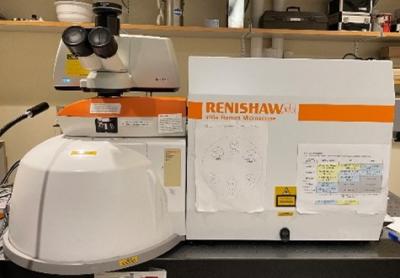
This is an inVia confocal Raman microscope for Raman spectroscopy. The pump wavelengths for Raman spectroscopy available are 458, 514, 633 and 785 nm. Samples can be film, powder, or liquid. There is also a temperature cell available to use with films or powder that has a temperature range from -173 to 600 °C. The instrument has been upgraded to include polarizers that can be added to the pump before and/or after it hits the sample. These polarizers can be added individually or in different combinations to get different combinations of polarized Raman.
PhotoThermal mIRage-LS
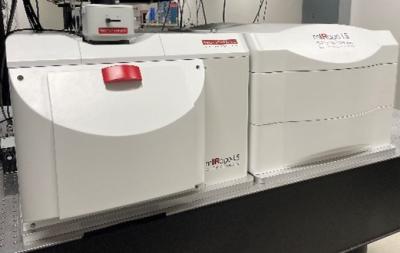
The mIRage-LS can measure IR and Raman microscopy signal simultaneously on the same spot. The probe laser at 532 and 785 nm are used to collect the optical photothermal infrared (OPTIR) signal and can also be used to collect the Raman signal. The spectral range for IR is 800-1850 and 2700-3600 cm-1. For a Raman spectrum the probe window is 200-3900 cm-1. The instrument has a spatial resolution of <500 nm for imaging.
Horiba Fluorolog-3

The Fluorolog-3 can be used for ground state emission and excitation. It has a Xe lamp to measure excitation from 200-900 nm. The emission spectrum can be measured 200-800 nm with the PMT or from 450-1050 with the CCD camera. It has a reflective sample configuration, so liquids and all types of solids can be run.
Shimadzu UV-3600

This is a UV/Vis/NIR spectrophotometer to measure absorption or transmission of samples from 200-3000 nm. It has a transmissive sample configuration, so only transparent samples can be run.
PerkinElmer Spectrum 65
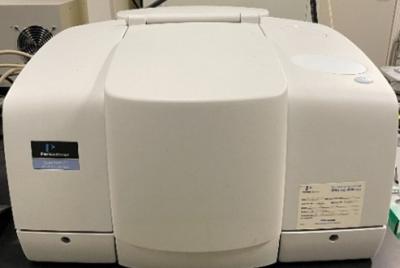
This is an FTIR spectrometer used to measure signal from IR vibrations form 15,700-100 cm-1. It has a transmissive sample configuration, so only transparent samples can be run.
Select Publications - Femtosecond Transient Absorption (fsTA)
Loftus, L. M.; Rack, J. J.; Turro, C.; Photoinduced ligand dissociation follows reverse energy gap law: nitrile photodissociation from low energy 3MLCT excited states, C. Chem. Commun., 2020, 56, 4070-4073.
Kender, W. T.; Turro, C.; Unusually Slow Internal Conversion in N-Heterocyclic Carbene/Carbanion Cyclometallated Ru(II) Complexes: A Hammett Relationship, J. Phys. Chem. A, 2019, 123 (13), 2650-2660.
Whittemore, T. J.; Millet, A.; Sayre, H. J.; Xue, C.; Dolinar, B. S.; White, E. G.; Dunbar, K. R.; Turro, C.; Tunable Rh2(II,II) Light Absorbers as Excited-State Electron Donors and Acceptors Accessible with Red/Near-Infrared Irradiation, J. Am. Chem. Soc. 2018, 140, 5161-5170.
Select Publications - Time-Resolved Infrared (TRIR)
Xue, C.; Sayre, H. J.; Turro, C.; Electron injection into titanium dioxide by panchromatic dirhodium photosensitizers with low energy red light, Chem. Commun., 2019, 55, 10428-10431.
Kender, W. T.; Turro, C.; Unusually Slow Internal Conversion in N-Heterocyclic Carbene/Carbanion Cyclometallated Ru(II) Complexes: A Hammett Relationship, J. Phys. Chem. A, 2019, 123 (13), 2650-2660.
Whittemore, T. J.; White, T. A.; Turro, C.; New Ligand Design Provides Delocalization and Promotes Strong Absorption throughout the Visible Region in a Ru(II) Complex, J. Am. Chem. Soc. 2018, 140, 229-234.
Staff
Dr. Barbara Dunlap | Manager | 0103 Newman & Wolfrom Laboratory | 614-247-4754 | dunlap.300@osu.edu
Dr. Claudia Turro | Faculty Director | 4109 Newman & Wolfrom Laboratory | 614-292-6708 | turro@chemistry.ohio-state.edu

